#14 May 1869
Photo



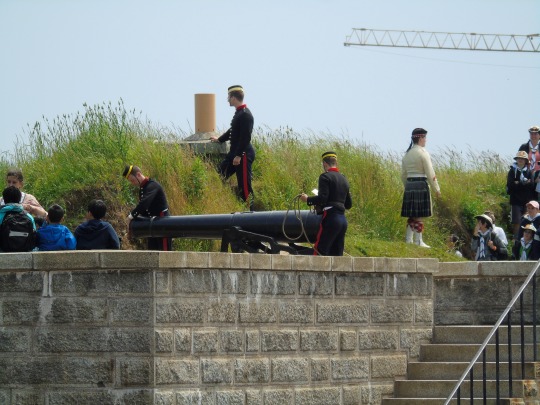




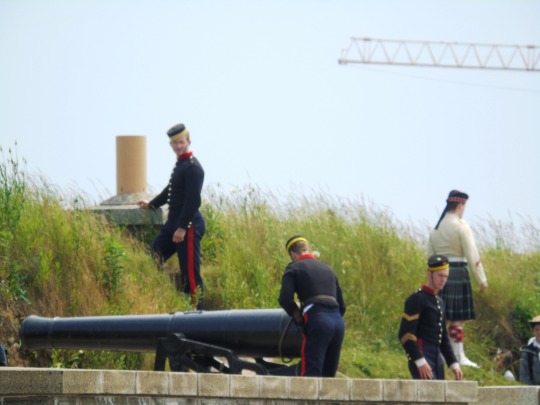
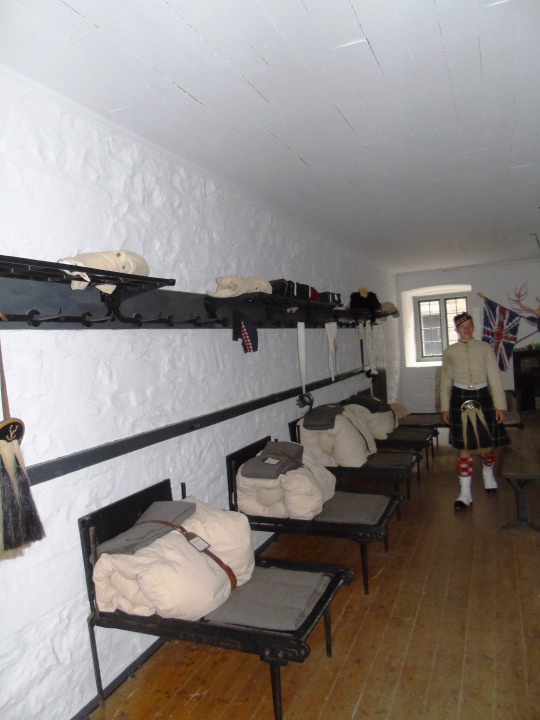
The renowned 78th Highlanders Regiment of Foot were stationed at Halifax for almost three years (1869-1871). The regiment arrived in Halifax on the afternoon of May 14, 1869, aboard the troopship HMS Crocodile.
A total of 765 men disembarked in full dress uniform. The Regiment was divided into two depots and eight service companies, consisting in all of 34 officers, 49 sergeants, 21 drummers, 6 pipers, and 600 rank and file.
#78th Highlanders Regiment of Foot#arrived#14 May 1869#anniversary#travel#Halifax Citadel National Historic Site of Canada#Fort George#vacation#Third Brigade of the Royal Artillery#noon cannon#tourist attraction#landmark#Nova Scotia#Canadian history#summer 2015#original photography#interior#exterior#architecture#cityscape
26 notes
·
View notes
Text

Il y a deux sortes de révolutions : les révolutions en arrière et les révolutions en avant. Révolutions pour révolutions, il vaut mieux servir celles de l'avenir ; car si l'avenir a des illusions, sans doute comme toute chose humaine, le passé n'a que des ruines.
Alphonse de Lamartine, Les pensées diverses (1869)
Je ne suis pas française, mais j'ai de la famille et des amis français. J'aime vivre en France. En tant que monarchiste, je n'aime pas la Révolution française, mais j'aime son histoire, sa culture et son peuple. C'est pour cette raison que je peux faire la fête aujourd'hui.
Je vous souhaite à tous une très bonne fête en ce 14 juillet !
Vive la France !
#lamartine#alphonse de lamartine#quote#france#french#french revolution#revolution#bastille day#fete nationale 2023#nation#history#paris#eiffel tower#celebrations#society
72 notes
·
View notes
Text
The napoleonic marshal‘s children
After seeing @josefavomjaaga’s and @northernmariette’s marshal calendar, I wanted to do a similar thing for all the marshal’s children! So I did! I hope you like it. c:
I listed them in more or less chronological order but categorised them in years (especially because we don‘t know all their birthdays).
At the end of this post you are going to find remarks about some of the marshals because not every child is listed! ^^“
To the question about the sources: I mostly googled it and searched their dates in Wikipedia, ahaha. Nevertheless, I also found this website. However, I would be careful with it. We are talking about history and different sources can have different dates.
I am always open for corrections. Just correct me in the comments if you find or know a trustful source which would show that one or some of the dates are incorrect.
At the end of the day it is harmless fun and research. :)
Pre 1790
François Étienne Kellermann (4 August 1770- 2 June 1835)
Marguerite Cécile Kellermann (15 March 1773 - 12 August 1850)
Ernestine Grouchy (1787–1866)
Mélanie Marie Josèphe de Pérignon (1788 - 1858)
Alphonse Grouchy (1789–1864)
Jean-Baptiste Sophie Pierre de Pérignon (1789- 14 January 1807)
Marie Françoise Germaine de Pérignon (1789 - 15 May 1844)
Angélique Catherine Jourdan (1789 or 1791 - 7 March 1879)
1790 - 1791
Marie-Louise Oudinot (1790–1832)
Marie-Anne Masséna (8 July 1790 - 1794)
Charles Oudinot (1791 - 1863)
Aimee-Clementine Grouchy (1791–1826)
Anne-Francoise Moncey (1791–1842)
1792 - 1793
Bon-Louis Moncey (1792–1817)
Victorine Perrin (1792–1822)
Anne-Charlotte Macdonald (1792–1870)
François Henri de Pérignon (23 February 1793 - 19 October 1841)
Jacques Prosper Masséna (25 June 1793 - 13 May 1821)
1794 - 1795
Victoire Thècle Masséna (28 September 1794 - 18 March 1857)
Adele-Elisabeth Macdonald (1794–1822)
Marguerite-Félécité Desprez (1795-1854); adopted by Sérurier
Nicolette Oudinot (1795–1865)
Charles Perrin (1795–15 March 1827)
1796 - 1997
Emilie Oudinot (1796–1805)
Victor Grouchy (1796–1864)
Napoleon-Victor Perrin (24 October 1796 - 2 December 1853)
Jeanne Madeleine Delphine Jourdan (1797-1839)
1799
François Victor Masséna (2 April 1799 - 16 April 1863)
Joseph François Oscar Bernadotte (4 July 1799 – 8 July 1859)
Auguste Oudinot (1799–1835)
Caroline de Pérignon (1799-1819)
Eugene Perrin (1799–1852)
1800
Nina Jourdan (1800-1833)
Caroline Mortier de Trevise (1800–1842)
1801
Achille Charles Louis Napoléon Murat (21 January 1801 - 15 April 1847)
Louis Napoléon Lannes (30 July 1801 – 19 July 1874)
Elise Oudinot (1801–1882)
1802
Marie Letizia Joséphine Annonciade Murat (26 April 1802 - 12 March 1859)
Alfred-Jean Lannes (11 July 1802 – 20 June 1861)
Napoléon Bessière (2 August 1802 - 21 July 1856)
Paul Davout (1802–1803)
Napoléon Soult (1802–1857)
1803
Marie-Agnès Irma de Pérignon (5 April 1803 - 16 December 1849)
Joseph Napoléon Ney (8 May 1803 – 25 July 1857)
Lucien Charles Joseph Napoléon Murat (16 May 1803 - 10 April 1878)
Jean-Ernest Lannes (20 July 1803 – 24 November 1882)
Alexandrine-Aimee Macdonald (1803–1869)
Sophie Malvina Joséphine Mortier de Trévise ( 1803 - ???)
1804
Napoléon Mortier de Trévise (6 August 1804 - 29 December 1869)
Michel Louis Félix Ney (24 August 1804 – 14 July 1854)
Gustave-Olivier Lannes (4 December 1804 – 25 August 1875)
Joséphine Davout (1804–1805)
Hortense Soult (1804–1862)
Octavie de Pérignon (1804-1847)
1805
Louise Julie Caroline Murat (21 March 1805 - 1 December 1889)
Antoinette Joséphine Davout (1805 – 19 August 1821)
Stephanie-Josephine Perrin (1805–1832)
1806
Josephine-Louise Lannes (4 March 1806 – 8 November 1889)
Eugène Michel Ney (12 July 1806 – 25 October 1845)
Edouard Moriter de Trévise (1806–1815)
Léopold de Pérignon (1806-1862)
1807
Adèle Napoleone Davout (June 1807 – 21 January 1885)
Jeanne-Francoise Moncey (1807–1853)
1808: Stephanie Oudinot (1808-1893)
1809: Napoleon Davout (1809–1810)
1810: Napoleon Alexander Berthier (11 September 1810 – 10 February 1887)
1811
Napoleon Louis Davout (6 January 1811 - 13 June 1853)
Louise-Honorine Suchet (1811 – 1885)
Louise Mortier de Trévise (1811–1831)
1812
Edgar Napoléon Henry Ney (12 April 1812 – 4 October 1882)
Caroline-Joséphine Berthier (22 August 1812 – 1905)
Jules Davout (December 1812 - 1813)
1813: Louis-Napoleon Suchet (23 May 1813- 22 July 1867/77)
1814: Eve-Stéphanie Mortier de Trévise (1814–1831)
1815
Marie Anne Berthier (February 1815 - 23 July 1878)
Adelaide Louise Davout (8 July 1815 – 6 October 1892)
Laurent François or Laurent-Camille Saint-Cyr (I found two almost similar names with the same date so) (30 December 1815 – 30 January 1904)
1816: Louise Marie Oudinot (1816 - 1909)
1817
Caroline Oudinot (1817–1896)
Caroline Soult (1817–1817)
1819: Charles-Joseph Oudinot (1819–1858)
1820: Anne-Marie Suchet (1820 - 27 May 1835)
1822: Henri Oudinot ( 3 February 1822 – 29 July 1891)
1824: Louis Marie Macdonald (11 November 1824 - 6 April 1881.)
1830: Noemie Grouchy (1830–1843)
——————
Children without clear birthdays:
Camille Jourdan (died in 1842)
Sophie Jourdan (died in 1820)
Additional remarks:
- Marshal Berthier died 8.5 months before his last daughter‘s birth.
- Marshal Oudinot had 11 children and the age difference between his first and last child is around 32 years.
- The age difference between marshal Grouchy‘s first and last child is around 43 years.
- Marshal Lefebvre had fourteen children (12 sons, 2 daughters) but I couldn‘t find anything kind of reliable about them so they are not listed above. I am aware that two sons of him were listed in the link above. Nevertheless, I was uncertain to name them in my list because I thought that his last living son died in the Russian campaign while the website writes about the possibility of another son dying in 1817.
- Marshal Augerau had no children.
- Marshal Brune had apparently adopted two daughters whose names are unknown.
- Marshal Pérignon: I couldn‘t find anything about his daughters, Justine, Elisabeth and Adèle, except that they died in infancy.
- Marshal Sérurier had no biological children but adopted Marguerite-Félécité Desprez in 1814.
- Marshal Marmont had no children.
- I found out that marshal Saint-Cyr married his first cousin, lol.
- I didn‘t find anything about marshal Poniatowski having children. Apparently, he wasn‘t married either (thank you, @northernmariette for the correction of this fact! c:)
#Marshal‘s children calendar#literally every napoleonic marshal ahaha#napoleonic era#Napoleonic children#I am not putting all the children‘s names into the tags#Thank you no thank you! :)#YES I posted it without double checking every child so don‘t be surprised when I have to correct some stuff 😭#napoleon's marshals#napoleonic
67 notes
·
View notes
Text
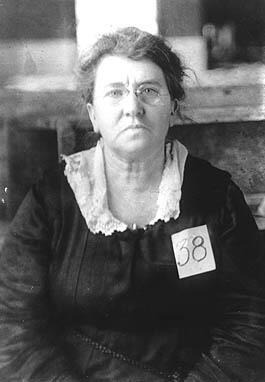
Anarchism, then, really stands for the liberation of the human mind from the dominion of religion; the liberation of the human body from the dominion of property; liberation from the shackles and restraint of government.
-Emma Goldman (June 27, 1869 – May 14, 1940)
She was an anarchist known for her political activism, writing, and speeches. Her writing and lectures spanned a wide variety of issues, including prisons, atheism, freedom of speech, militarism, capitalism, marriage, free love, and homosexuality.
69 notes
·
View notes
Text


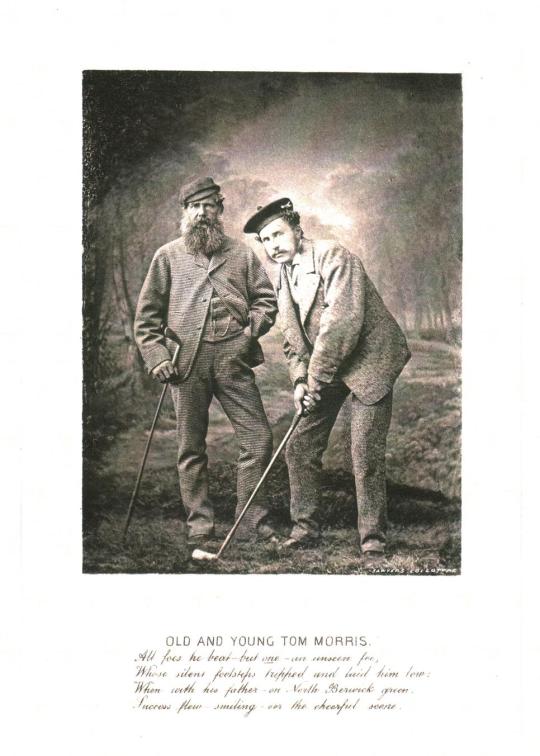
On 20th April 1851 Tom Morris Jnr was born in St Andrews.
Being born in St Andrews to Tom Morris senior, Junior ended up with the tag “Young Tom” and his father “Old Tom” both were great golfers when the sport was just taking off, Young Tom won 4 Open Championships and would undoubtedly have won more if it wasn’t for his untimely and tragic death at the age of just 24.
Morris’ introduction to golf came over the Prestwick Golf Links, where his father was the greenskeeper. When he was 13, Young Tom beat Old Tom in a match for the first time - his father was the reigning Open champion, so that was a pretty big achievement.
Young Tom played in the Open for the first time in 1865, when he was just 14 years old and won became Open Champion at just 17 in 1868, retaining the title in 1869 and winning again in 1870. At this time the golfers were playing for the Championship belt and the rules stated three straight wins and you got to keep the belt, it left the tournament organizers with a problem: They no longer had anything to present to the winner.
There was no tournament in 1871 (largely because there was no “trophy” to present), but by 1872 the now-famous “Claret Jug” was ready, and Young Tom Morris won that trophy, too, in its first year.
Tommy also recorded the first hole-in-one in the history of professional golf in the first round of the 1869 Open Championship at Prestwick, acing the 166 yard Station Hole.
Three years later, Morris was playing an exhibition match when he received word that his pregnant wife, Margaret, had gone into a difficult labour. Only two holes remained in the match; Old Tom and Young Tom finished the match, winning, and hurried home by ship across the Firth of Forth and up the coast, but when Young Tom got there both his wife and newborn baby were dead. Young Tom was broken-hearted. Not quite four months later, on Christmas Day, he too died, they say of a broken heart but he had played a match three weeks previous in appalling conditions and on his death it was discovered he had a bleed in his lungs so his love of the game and Scotland's harsh weather may have weakened him.
Who knows how many more titles he would have won, his father remains the oldest Open winner at 46 years old.
Young Tom Morris was outlived by Old Tom by more than 30 years. He is buried beside his wife and son in the Cathedral Burial Ground at St. Andrews, a memorial to him is beside his grave as seen in the pic.
9 notes
·
View notes
Text
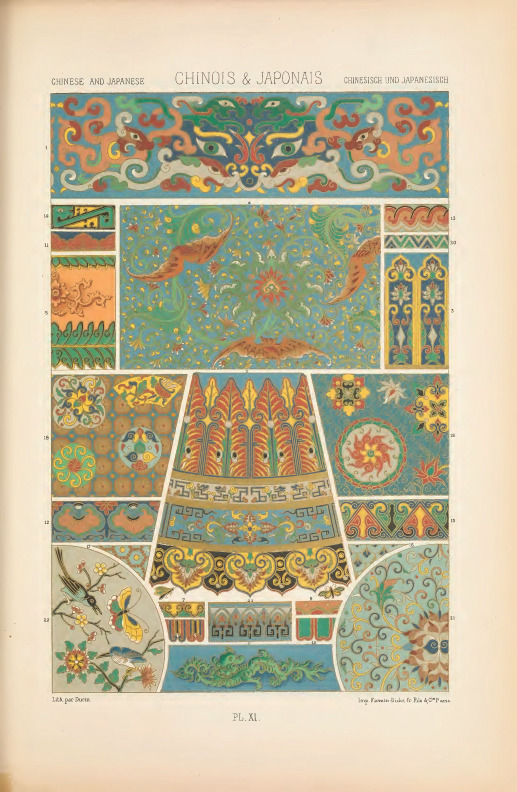
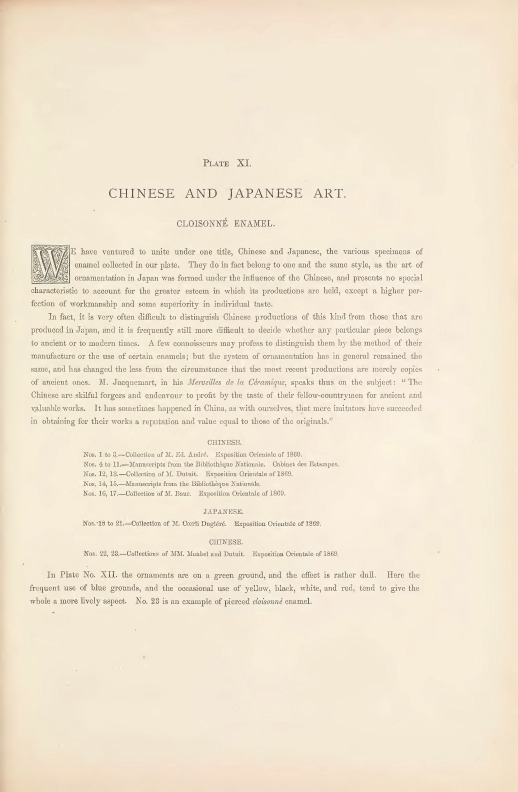
Albert Racinet's "Polychrome Ornament," 1869
PLATE XI.
CHINESE AND JAPANESE ART.
CLOISONNE ENAMEL.
WE have ventured to unite under one title, Chinese and Japanese, the various specimens of enamel collected in our plate. They do in fact belong to one and the same style, as the art of ornamentation in Japan was formed under the influence of the Chinese, and presents no special characteristic to account for the greater esteem in which its productions are held, except a higher perfection of workmanship and some superiority in individual taste.
In fact, it is very often difficult to distinguish Chinese productions of this kind from those that arc produced in Japan, and it is frequently still more difficult to decide whether any particular piece belongs to ancient or to modern times. A few connoisseurs may profess to distinguish them by the method of their manufacture or the use of certain enamels; but the system of ornamentation has in general remained the same, and has changed the less from the circumstance that the most recent productions are merely copies of ancient ones. M. Jacquemart, in his Merveilles de la Ceramique, speaks thus on the subject: "The Chinese are skilful forgers and endeavor to profit by the taste of their fellow-countrymen for ancient and valuable works. It has sometimes happened in China, as with ourselves, that mere imitators have succeeded in obtaining for their works a reputation and value equal to those of the originals."
CHINESE.
Nos. l to 3.-Collection of 11L Ed. Andre. Exposition Orientale of 1869.
Nos. 4 to 11.-Manuscripts from the Bibliotheque Nationale Cabinet des Esfampes.
Nos. 12, 13.-Collection of M Dutnit. Exposition Orientale of 1869.
Nos. 14, 15.-:Manuscripts from the Bibliothegue Nationale.
Nos. 16, 17 .-Collection of M. Baur. Exposition Orientale of 1869.
JAPANESE.
Nos.·18 to 21.-Collection of M. Coerli Duglere. Exposition Orieutale of 1869.
CHINESE.
Nos. 22 - 23.-Collections of MM. Monbel and Dutuit. Exposition Orientale of 1869.
#art#1800s#1800s art#cultural art#albert racinet#antiquity#illustration#design#ancient art#ancient china#ancient japan#chinese art#japanese art#aesthetic#chinese aesthetic#japanese aesthetic#19th century
9 notes
·
View notes
Text

The U.S. 1870-S $3 Gold Coin
A great numismatic rarity was interred in the northeast cornerstone of the second San Francisco Mint on May 25, 1870, during a Masonic ceremony covered by the press. Struck especially for the event using modified dies, the 1870-S $3 gold coin joined a number of other extraordinary numismatic rarities in a copper casket in the new facility’s cornerstone, ostensibly out of collectors’ reach. The facility was completed in 1874 and would go on to serve the western region of the nation’s coinage needs until 1937.
In 1907, almost four decades after the cornerstone was laid, a second 1870-S $3 gold coin was offered in an ad published in The Numismatist by dealer H.T. VanCamp that declared:
“HERE IS A COIN ALL ALONE BY ITSELF. Never in circulation – Never before in the market. With the Coin is an interesting little history by the Coiner who made it.”
The Mint’s cornerstone remained intact, raising questions about the purported uniqueness of the 1870-S.
It was a mystery that took more than a century to unravel.
In March 2004, numismatic researchers Nancy Oliver and Richard Kelly uncovered a Mint document confirming details of the creation of an 1870-S $3 gold coin and its placement in the second San Francisco Mint building’s cornerstone.
Two sets of Indian Princess three-dollar gold dies dated 1870 were shipped to San Francisco in December of 1869. The “S” mint mark was not punched into the dies before they left Philadelphia for San Francisco. Joseph Breck Harmstead, a coiner at the San Francisco Mint, hand-carved the mint mark into one of the dies and struck a coin for inclusion in the casket. Harmstead had previously worked at the Philadelphia, New Orleans, and Carson City Mints, and was promoted to coiner in 1869 at the first San Francisco Mint.
Mr. Harmstead struck a second example of the 1870-S $3 gold coin as a gift for his niece Georgine and included a letter explaining the coin’s origin, according to Kelly and Oliver’s research. The letter read “This Three Dollar piece is a duplicate of one under the cornerstone of the San Francisco Mint and the only one in existence (Dannreuther, 453).” Researchers wonder if that letter was the “interesting little history” VanCamp mentioned in his ad.
Harmstead’s letter to his niece remains elusive, evading a number of researchers. Kelly thinks that the letter was hidden or destroyed by someone to “maintain the coin’s supposed uniqueness.” Harmstead’s niece Georgine was living in New York as a widow by 1900, and Kelly and Oliver think that she sold the coin to VanCamp around 1907 before passing away in 1910. The author of this article is not aware whether the letter turned up. If it has, we would welcome your correspondence.
The numerals “893” were scratched into the coin’s surface at some point in its history. Kelly, Oliver, and Dannreuther think they refer to the coin’s fineness, while Doug Winter, an expert on early U.S. gold coinage, disagrees. In a phone interview conducted on January 14 of this year, Winter said that he has “never heard a good explanation as to what those numerals stand for.”
The “primary” example of the coin remains sealed in the cornerstone of the second San Francisco Mint along with a number of other rarities.

The 1870-S $3 gold coin passed through the hands of a number of prominent numismatists after it surfaced. William H. Woodin bought the coin from Van Camp in 1907. In 1911, it was sold from Woodin’s collection. Waldo Newcomer purchased the coin and placed it in his legendary collection. Colonel E.H.R. Green owned the coin from 1931 to 1936. Two prominent coin dealers, B. Max Mehl and Abe Kosoff, both handled the coin. In December 1945, dealers Ted and Carl Brandts published a full-page ad in the Numismatist offering the coin, calling it “the only coin listed as Unique in the Standard Catalogue of United States Coins“. Louis Eliasberg, a famous New York numismatist, bought the coin in 1946 and it remained in his collection for nearly four decades. Harry W. Bass Jr. bought the coin in 1982 for $687,500 from Bowers and Ruddy’s Eliasberg Sale. The latter portions of its long, star-studded provenance earned it the nickname “Eliasberg-Bass Specimen”. Since 2000, the Eliasberg-Bass Specimen has been on display at the American Numismatic Association’s Edward C. Rochette Money Museum in the Harry W. Bass Jr. Collection, part of the only complete collection of U.S. $3 gold coins.
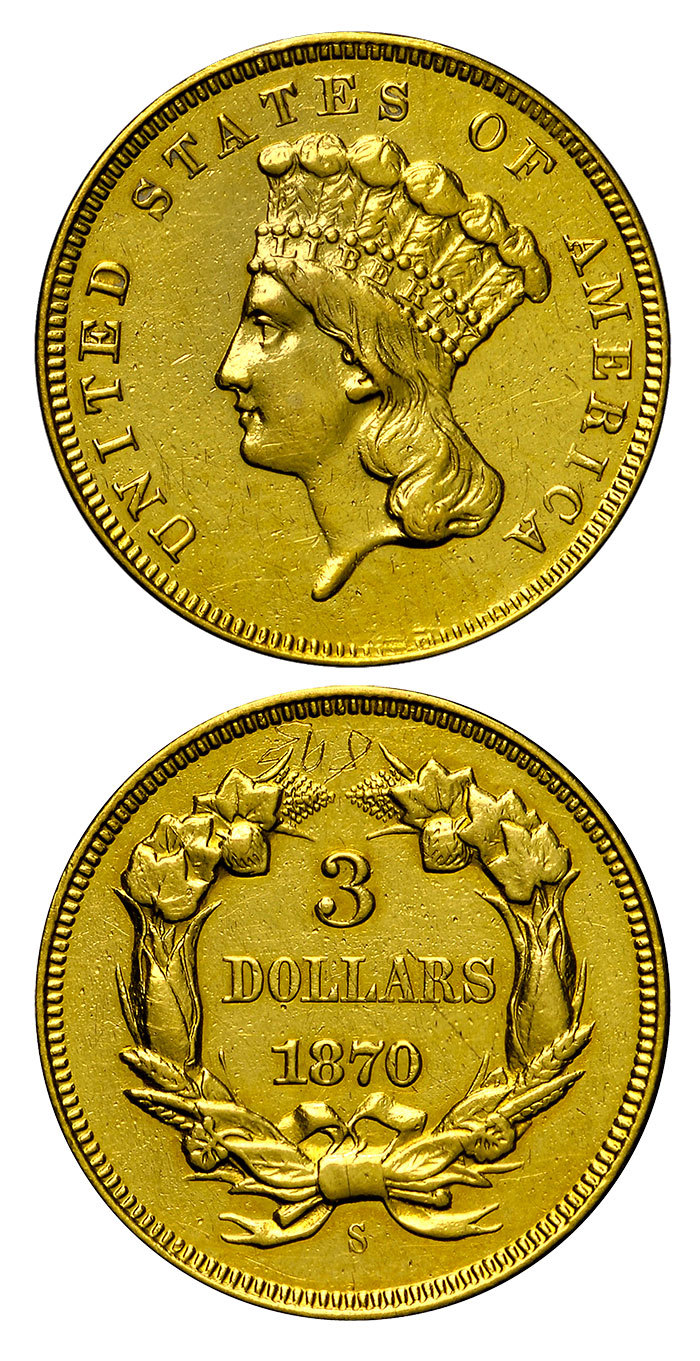
As for condition, the coin exhibits detail consistent with a grade of Extremely Fine. Many observers point to its “pebbled” appearance as evidence of it being used in jewelry. The Harry Bass Jr. Foundation’s website describes the obverse and reverse:
Obverse: Die scratch from denticle above O(F) to (O)F. Reused for Proofs of 1874 and 1875. Very lightly hubbed; tops only of J.B.L. visible, portion of front of headdress missing (distinctive). No ‘Ghosting’. Reverse: Open 3. Date very low, barely above ribbon loop; level relative to DOLLARS. All characters firmly punched and distinct. Left interior leaf opposite date is a thin, broken remnant with minuscule base at junction with wreath leaf below. Right interior leaf is thin. Lower one-third of left bow loop and center space filled. Right loop clear with but a stub of vertical ribbon element within, and none projecting into field from top of right loop.
The Bass description makes no mention of the graffiti that mars the top of the reverse or the tiny “3” that appears on the leaf that runs parallel and to the left of the bottom of the three.
A Third Example Surfaces?
In 2012, gold collectors sat up and took notice as Georgia-based Four Season Auction Gallery claimed that another 1870-S gold $3 coin had been discovered in San Francisco and would be auctioned. Four Seasons claimed that the coin was found embedded in a souvenir book by a European tourist in 1997, and the coin drew widespread media attention; Fox News reported the auction firm’s claim that the coin could fetch $3 or $4 million.
A number of experts doubted the coin’s authenticity and before the auction, it was not authenticated by any reputable grading service, and ultimately, the coin was withdrawn. Dave Harper wrote critically in Numismatic News:
“If I had $2 million or $4 million, I certainly would not be bidding on what is claimed to be a possible second example of an 1870-S $3 gold piece.”
While the Four Season coin’s authenticity has never been established, the firm’s estimate of its potential value (had it been authentic) was not far off. Doug Winter shared an estimate of the 1870-S $3 gold coin’s value on the CoinWeek Podcast as being $5 million. In talking about the Bass coin, how on exhibit at the ANA’s Money Museum, he elaborated that such a coin would likely only interest experienced collectors because of its impaired appearance and niche appeal.
“It’s not an especially attractive coin,” Winter said. “I think it would be very difficult to get somebody that knows nothing about coins excited about a no-grade 1870-S $3.”
Nevertheless, the 1870-S $3 gold piece was ranked #17 among in the fifth edition of Jeff Garrett’s 100 Greatest U.S. Coins. It is an exceptionally rare coin about which many stories have been told. Far from a perfect coin, its murky history, and impressive provenance place it among the most notable American numismatic rarities and an enigma in the U.S. series.
And you can’t assemble a complete collection of U.S. coins without it.
Coin Specifications
Country: USA
Year Of Issue: 1870
Denomination: Three Dollars
Mint Mark: S (San Francisco)
Mintage: 2
Alloy: .900 gold, .100 copper
Weight: 5.015 g
Diameter: 20.5 mm
Edge: Reeded
OBV Designer James B. Longacre
REV Designer James B. Longacre
Quality: Business Strike
By CoinWeek IQ.
#The U.S. 1870-S $3 Gold Coin#gold#gold coin#collectable coins#rare#unique#treasure#ancient artifacts#history#history news#long reads
26 notes
·
View notes
Text
Today the Church remembers the 108 Blessed Polish Martyrs.
Orate pro nobis.
The 108 Blessed Polish Martyrs were Roman Catholic Christians in Poland killed during World War II by the Nazis, either in the concentration camps or by mass slaughter on the streets. The group comprises 3 bishops, 79 priests, 7 male religious, 8 female religious, and 11 lay people. There are two parishes named for the 108 Martyrs of World War II in Powiercie in Koło County, and in Malbork, Poland.
The 108 Blessed Martyrs were beatified on 13 June 1999 by Pope John Paul II in Warsaw, Poland.
List of Martyrs
Bishops
1. Antoni Julian Nowowiejski (1858–1941 KL Soldau), bishop
2. Leon Wetmański (1886–1941 KL Soldau), bishop
3. Władysław Goral (1898–1945 KL Sachsenhausen), bishop
Priests
1. Adam Bargielski, priest from Myszyniec (1903–1942 KZ Dachau)
2. Aleksy Sobaszek, priest (1895–1942 KL Dachau)
3. Alfons Maria Mazurek, Carmelite friar, prior, priest (1891–1944, shot by the Gestapo)
4. Alojzy Liguda, Society of the Divine Word, priest (1898–1942 KL Dachau)
5. Anastazy Jakub Pankiewicz, Franciscan friar, priest (1882–1942 KL Dachau)
6. Anicet Kopliński, Capuchin friar, priest in Warsaw (1875–1941)
7. Antoni Beszta-Borowski, priest, dean of Bielsk Podlaski (1880–1943, shot near Bielsk Podlaski)
8. Antoni Leszczewicz, Marian Father, priest (1890–1943, burnt to death in Rosica, Belarus)
9. Antoni Rewera, priest, dean of the Cathedral Chapter in Sandomierz (1869–1942 KL Dachau)
10. Antoni Świadek, priest from Bydgoszcz (1909–1945 KL Dachau)
11. Antoni Zawistowski, priest (1882–1942 KL Dachau)
12. Bolesław Strzelecki, priest (1896–1941 KL Auschwitz)
13. Bronisław Komorowski, priest (1889–22 March 1940 KL Stutthof)
14. Dominik Jędrzejewski, priest (1886–1942 KL Dachau)
15. Edward Detkens, priest (1885–1942 KL Dachau)
16. Edward Grzymała, priest (1906–1942 KL Dachau)
17. Emil Szramek, priest (1887–1942 KL Dachau)
18. Fidelis Chojnacki, Capuchin friar, priest (1906–1942, KL Dachau)
19. Florian Stępniak, Capuchin friar, priest (1912–1942 KL Dachau)
20. Franciszek Dachtera, priest (1910–23 August 1942 KL Dachau)
21. Franciszek Drzewiecki, Orionine Father, priest (1908–1942 KL Dachau); from Zduny, he was condemned to heavy work in the plantation of Dachau. While he was bending over tilling the soil, he adored the consecrated hosts kept in a small box in front of him. While he was going to the gas chamber, he encouraged his companions, saying "We offer our life for God, for the Church and for our Country".
22. Franciszek Rogaczewski, priest from Gdańsk (1892–1940, shot in Stutthof or in Piaśnica, Pomerania)
23. Franciszek Rosłaniec, priest (1889–1942 KL Dachau)
24. Henryk Hlebowicz, priest (1904–1941, shot at Borisov in Belarus)
25. Henryk Kaczorowski, priest from Włocławek (1888–1942)
26. Henryk Krzysztofik, religious priest (1908–1942 KL Dachau)
27. Hilary Paweł Januszewski, religious priest (1907–1945 KL Dachau)
28. Jan Antonin Bajewski, Conventual Franciscan friar, priest (1915–1941 KL Auschwitz); of Niepokalanow. These were the closest collaborators of St Maximilian Kolbe in the fight for God's cause and together suffered and helped each other spiritually in their offering their lives at Auschwitz
29. Jan Franciszek Czartoryski, Dominican friar, priest (1897–1944)
30. Jan Nepomucen Chrzan, priest (1885–1942 KL Dachau)
31. Jerzy Kaszyra, Marian Father, priest (1910–1943, burnt to death in Rosica, Belarus)
32. Józef Achilles Puchała, Franciscan friar, priest (1911–1943, killed near Iwieniec, Belarus)
33. Józef Cebula, Missionary Oblate, priest (23 March 1902 – 9 May 1941 KL Mauthausen)[
34. Józef Czempiel, priest (1883–1942 KL Mauthausen)
35. Józef Innocenty Guz, Franciscan friar, priest (1890–1940 KL Sachsenhausen)
36. Józef Jankowski, Pallotine, priest (1910 born in Czyczkowy near Brusy, Kashubia (died 16 October 1941 in KL Auschwitz beaten by a kapo)
37. Józef Kowalski, Salesian, priest (1911–1942) , priest beaten to death on 3 July 1942 in the KL Auschwitz concentration camp
38. Józef Kurzawa, priest (1910–1940)
39. Józef Kut, priest (1905–1942 KL Dachau)
40. Józef Pawłowski, priest (1890–9 January 1942 KL Dachau)
41. Józef Stanek, Pallottine, priest (1916–23 September 1944, murdered in Warsaw)
42. Józef Straszewski, priest (1885–1942 KL Dachau)
43. Karol Herman Stępień, Franciscan friar, priest (1910–1943, killed near Iwieniec, Belarus)
44. Kazimierz Gostyński, priest (1884–1942 KL Dachau)
45. Kazimierz Grelewski, priest (1907–1942 KL Dachau)
46. Kazimierz Sykulski, priest (1882–1942 KL Auschwitz)
47. Krystyn Gondek, Franciscan friar, priest (1909–1942 KL Dachau)
48. Leon Nowakowski, priest (1913–1939)
49. Ludwik Mzyk, Society of the Divine Word, priest (1905–1940)
50. Ludwik Pius Bartosik, Conventual Franciscan friar, priest (1909–1941 KL Auschwitz); of Niepokalanow. These were the closest collaborators of St Maximilian Kolbe in the fight for God's cause and together suffered and helped each other spiritually in their offering their lives at Auschwitz
51. Ludwik Roch Gietyngier, priest from Częstochowa (1904–1941 KL Dachau)
52. Maksymilian Binkiewicz, priest (1913–24 July 1942, beaten, died in KL Dachau)
53. Marian Gorecki, priest (1903–22 March 1940 KL Stutthof)
54. Marian Konopiński, Capuchin friar, priest (1907–1 January 1943 KL Dachau)
55. Marian Skrzypczak, priest (1909–1939 shot in Plonkowo)
56. Michał Oziębłowski, priest (1900–1942 KL Dachau)
57. Michał Piaszczyński, priest (1885–1940 KL Sachsenhausen)
58. Michał Woźniak, priest (1875–1942 KL Dachau)
59. Mieczysław Bohatkiewicz, priest (1904–4 March 1942, shot in Berezwecz)
60. Narcyz Putz, priest (1877–1942 KL Dachau)
61. Narcyz Turchan, priest (1879–1942 KL Dachau)
62. Piotr Edward Dankowski, priest (1908–3 April 1942 KL Auschwitz)
63. Roman Archutowski, priest (1882–1943 KL Majdanek)
64. Roman Sitko, priest (1880–1942 KL Auschwitz)
65. Stanisław Kubista, Society of the Divine Word, priest (1898–1940 KL Sachsenhausen)
66. Stanisław Kubski, priest (1876–1942, prisoner in KL Dachau, killed in Hartheim near Linz)
67. Stanisław Mysakowski, priest (1896–1942 KL Dachau)
68. Stanisław Pyrtek, priest (1913–4 March 1942, shot in Berezwecz)
69. Stefan Grelewski, priest (1899–1941 KL Dachau)
70. Wincenty Matuszewski, priest (1869–1940)
71. Władysław Błądziński, Michaelite, priest (1908–1944, KL Gross-Rosen)
72. Władysław Demski, priest (1884–28 May 1940, KL Sachsenhausen)
73. Władysław Maćkowiak, priest (1910–4 March 1942 shot in Berezwecz)
74. Władysław Mączkowski, priest (1911–20 August 1942 KL Dachau)
75. Władysław Miegoń, priest, commander lieutenant (1892–1942 KL Dachau)
76. Włodzimierz Laskowski, priest (1886–1940 KL Gusen)
77. Wojciech Nierychlewski, religious, priest (1903–1942, KL Auschwitz)
78. Zygmunt Pisarski, priest (1902–1943)
79. Zygmunt Sajna, priest (1897–1940, shot at Palmiry, near Warsaw)
Religious brothers
1. Brunon Zembol, friar (1905–1942 KL Dachau)
2. Grzegorz Bolesław Frąckowiak, Society of the Divine Word friar (1911–1943, guillotined in Dresden)
3. Józef Zapłata, friar (1904–1945 KL Dachau)
4. Marcin Oprządek, friar (1884–1942 KL Dachau)
5. Piotr Bonifacy Żukowski, friar (1913–1942 KL Auschwitz)
6. Stanisław Tymoteusz Trojanowski, friar (1908–1942 KL Auschwitz)
7. Symforian Ducki, friar (1888–1942 KL Auschwitz)
Nuns and religious sisters
1. Alicja Maria Jadwiga Kotowska, sister, based on eye-witness reports comforted and huddled with Jewish children before she and the children were executed (1899–1939, executed at Piaśnica, Pomerania)
2. Ewa Noiszewska, sister (1885–1942, executed at Góra Pietrelewicka near Slonim, Belarus)
3. Julia Rodzińska, Dominican sister (1899–20 February 1945, KL Stutthof); she died having contracted typhoid serving the Jewish women prisoners in a hut for which she had volunteered.
4. Katarzyna Celestyna Faron (1913–1944, KL Auschwitz); (1913–1944), had offered her life for the conversion of an Old Catholic bishop Władysław Faron (no relation). She was arrested by the Gestapo and condemned to Auschwitz camp. She put up heroically with all the abuses of the camp and died on Easter Sunday 1944. The bishop later returned to the Catholic Church).
5. Maria Antonina Kratochwil, SSND nun (1881–1942) died as a result of the torture she endured while imprisoned in Stanisławów.
6. Maria Klemensa Staszewska (1890–1943 KL Auschwitz)
7. Marta Wołowska (1879–1942, executed at Góra Pietrelewicka near Slonim, Belarus)
8. Mieczysława Kowalska, sister (1902–1941, Soldau concentration camp in Działdowo)
Roman Catholic laity
1. Bronisław Kostkowski, alumnus (1915–1942 KL Dachau)
2. Czesław Jóźwiak (1919–1942, guillotined in a prison in Dresden)
3. Edward Kaźmierski (1919–1942, guillotined in a prison in Dresden)
4. Edward Klinik (1919–1942, guillotined in a prison in Dresden)
5. Franciszek Kęsy (1920–1942, guillotined in a prison in Dresden)
6. Franciszek Stryjas (1882–31 July 1944, Kalisz prison)
7. Jarogniew Wojciechowski (1922–1942, guillotined in a prison in Dresden)
8. Marianna Biernacka (1888–13 July 1943), executed instead of her pregnant daughter-in-law Anna, offered her life for her and her unborn grandchild)
9. Natalia Tułasiewicz (1906–31 March 1945, died in KL Ravensbrück)
10. Stanisław Starowieyski (1895–1941 in KL Dachau)
11. Tadeusz Dulny, alumnus (1914–1942 KL Dachau)
Almighty God, by whose grace and power your Holy Martyrs of Poland triumphed over suffering and were faithful even to death: Grant us, who now remember them in thanksgiving, to be so faithful in our witness to you in this world, that we may receive with them the crown of life; through Jesus Christ our Lord, who lives and reigns with you and the Holy Spirit, one God, forever and ever. Amen.
(Fr. Józef Kowalski, priest beaten to death on 3 July 1942 in the KL Auschwitz concentration camp)
(Sr. Alicja Jadwiga Kotowska, a nun killed protecting a group of Jewish children in 1939 in the mass murders in Piaśnica)

#father troy beecham#christianity#jesus#saints#god#salvation#peace#martyrs#faith#christian persecution
39 notes
·
View notes
Text
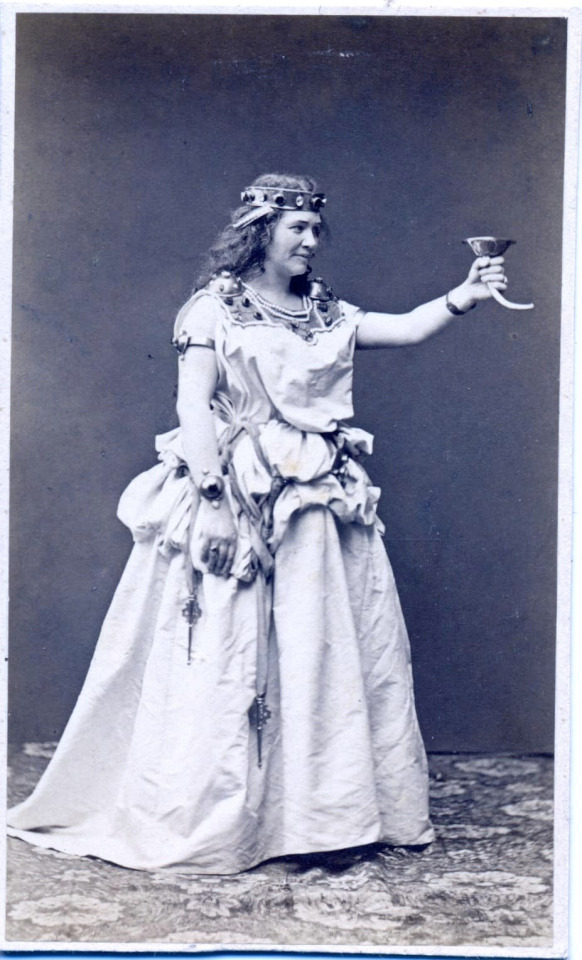
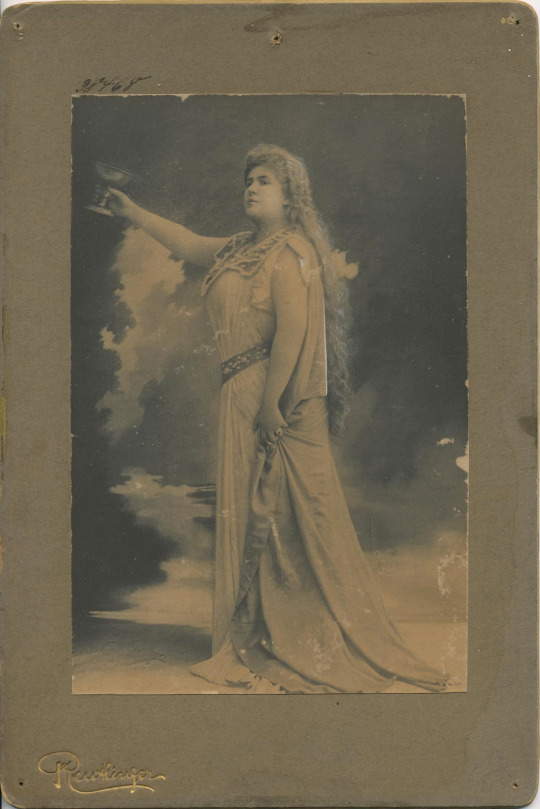


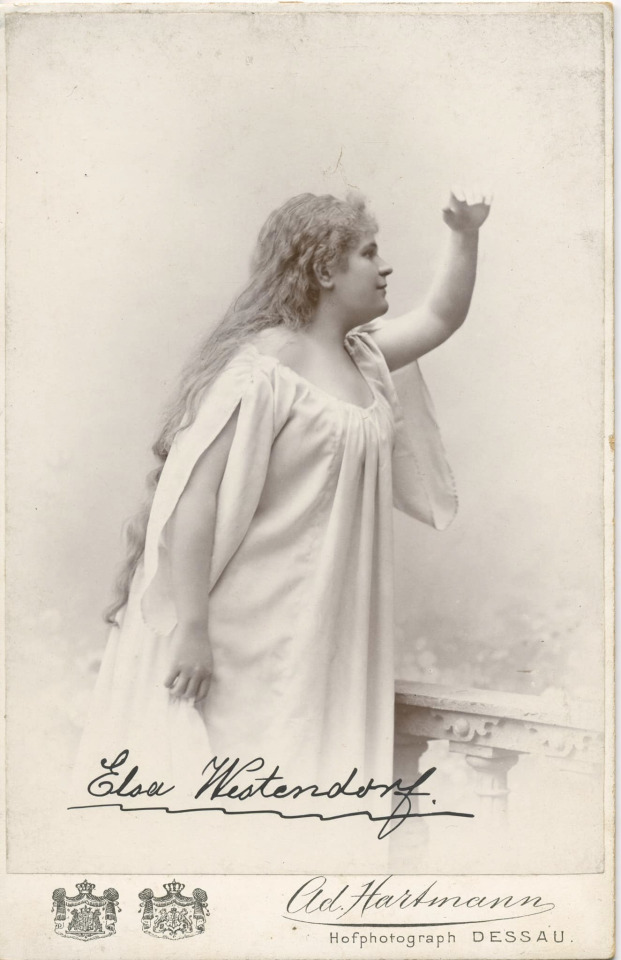



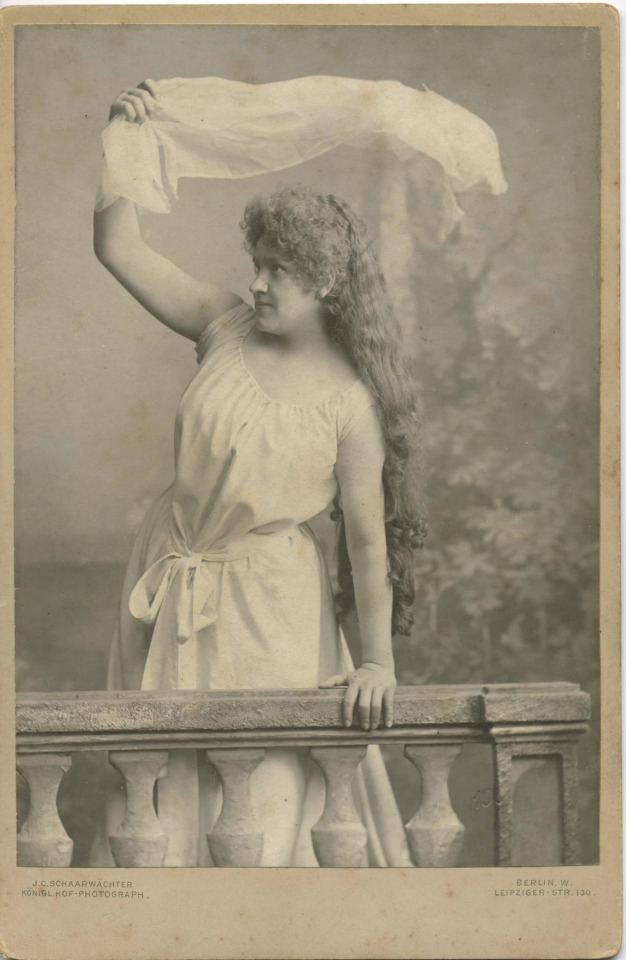
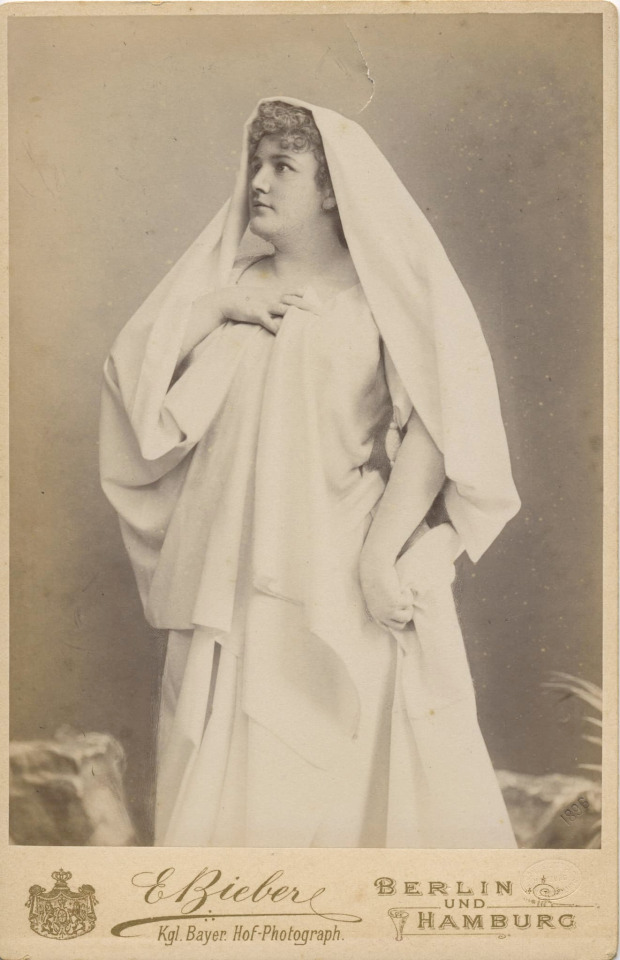

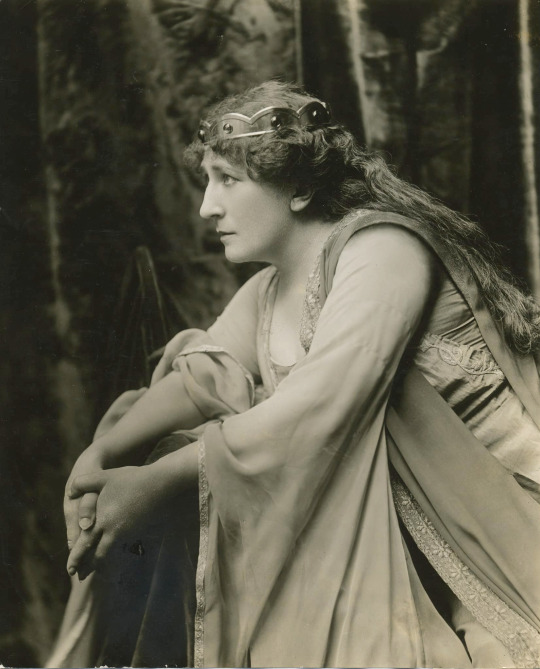
On June 10, 1865, the world premiere of "Tristan and Isolde" by R. Wagner took place in Munich.
„Mild und leise wie er lächelt…“
Here are some of the first sopranos to have sung the role of Isolde over the years and contributed to the success of this work through their dedication.
Malvina Schnoor von Carolsfeld, (7 December 1825 – 8 February 1904), Danish-born Portuguese dramatic soprano.
Felia Litvinne (11 October 1860, Saint Petersburg – 12 October 1936, Paris) was a Russian-born, French-based dramatic soprano.
Italia Vasquez-Molina (1869-1945), Italian soprano.
Irma von Voggenhuber (17 July 1841 Budapest - 11 January 1888 Berlin), soprano.
Elsa Westendorf (1877-1918), German soprano.
Marie Wittich 27 May 1868 – 4 August 1931), German dramatic soprano.
Rosa Sucher (23 February 1849 – 16 April 1927), German dramatic soprano.
Berta Pester-Prosky (Frankfurt am Main, September 7, 1866 - Krefeld, December 27, 1922), German soprano.
Thila Plaichinger (14 March 1868 – 19 March 1939), Austrian soprano.
Katharina Klafsky (19 September 1855 – 22 September 1896), Hungarian dramatic soprano.
Margot Kaftal (1873 Warsaw - October 1942 in Italy), Polish soprano.
Johanna Gadski (15 June 1870/1872 – 22 February 1932), German dramatic soprano.
#opera#classical music#music history#bel canto#composer#classical composer#aria#classical studies#Tristan and Isolde#classical musician#classical musicians#musician#musicians#classical history#historian of music#diva#prima donna#maestro#chest voice#Tristan und Isolde#Richard Wagner#Wagner#soprano#classical singer#classical singing#opera history#history#music
25 notes
·
View notes
Text
Le foil est une aile positionnée sous un support une coque de bateau ou planche, qui vise à réduire les frottements avec l’eau pour agir sur la vitesse et la stabilité du support grâce à la force de portance. Pour le sport on utilise les termes de Kitefoil, Windfoil, Wingfoil, SUPfoil, Surf-foil et Wakefoil. Une nouveauté pour vous certainement cependant il fut inventé en 1868
L’historique du foil, depuis plus d’un siècle les ingénieurs et architectes navals ont voulu trouver une nouvelle technologie qui permette à un bateau d’augmenter sa vitesse en surélevant la coque au dessus de l’eau. En 1869, Emmanuel Farcot dépose un brevet d’un bateau hérissé de nombreux petits foils le long de la coque afin de diminuer la trainée. A partir de 1894, l’américain William E. Meacham pousse plus loin le concept des foils. Il invente le bateau de 14 pieds détenant le plus vieux record dans ce domaine. En 1960, Thomas Moy adapte trois plans sur un bateau qu’il fera naviguer sur « Grand Surrey Canal », au sud de Londres. En 1976, Eric Tabarly élabore un prototype qui est la genèse du trimaran, après les années 2000, le concept du foil a été créé grâce à l’invention de matériaux plus résistants comme le carbone. De nos jours la notion de foil est très peu connue, mais c’est un concept impressionnant et très convoité par le monde de la navigation. Une nouvelle génération de bateau a été construit comme « l’hydroptère ». Dernièrement, les foils se sont modernisés dans le but de gagner de plus en plus de vitesse







The history of the foil, for more than a century naval engineers and architects have wanted to find a new technology that allows a boat to increase its speed by raising the hull above the water. In 1869, Emmanuel Farcot filed a patent for a boat bristling with numerous small foils along the hull in order to reduce drag. From 1894, the American William E. Meacham pushed the concept of foils further. He invented the 14-foot boat holding the oldest record in this field. In 1960, Thomas Moy adapted three plans for a boat that he would sail on the "Grand Surrey Canal", south of London. In 1976, Eric Tabarly developed a prototype which was the genesis of the trimaran, after the 2000s, the concept of the foil was created thanks to the invention of more resistant materials such as carbon. Nowadays the concept of foil is very little known, but it is an impressive concept and very coveted by the world of navigation. A new generation of boat was built as the “hydrofoil”. Lately, foils have been modernized in order to gain more and more speed

Le projet de Tanguy le Bihan sur l'hybride foiling. Dès lors une découverte et peut-être un essai sur le Lac d'Annecy
11 notes
·
View notes
Photo




The Jail
Check out the video here!!
https://youtu.be/eaoU2NxzUJo
In 1889 the Governor's Residence was built, let's take a peak at what it looked like!!
PSA: Please don't mention where the location is in the comments.
The original gaol building which includes two L-shaped portions as well as the original exercise yard were completed in 1854. It is a stone walled two-storey building with a gable roof.
In 1869 a new two-storey jail was built using limestone blocks along with three new jail yards. One of the jail yards may have been used for executions by hanging where people would gather to watch. Later in 1877 a third storey addition was built adding 14 more cells to the jail.
In 1889 the Governor's residence was constructed. It is a two and one-half storey red brick building.
Here are a few interesting facts about the prison:
Up until the 1850s when the first jail was built, jailers would often have to keep prisoners in there own homes.
The prisoners would be confined to their cells for most of the day and night, they were made of stone and likely very cold and only three feet wide!
The first prisoners, a man and his mother were being held in the prison temporarily before they were moved to a larger facility. The gaol was not finished yet, the surrounding walls had not been built and there was scaffolding surrounding the building. Some friends of the inmates came and removed the scaffolding and pried the bars off. The mother would be captured a year later but the son was never caught.
In 2011 the jail was permanently closed and vacated and ownership was transferred to the city. It has sat vacant ever since. The jail is also listed on the city's heritage registry.
Since then the city has listed the building for sale many times, one time being for as little as $1. They have issued a request for proposals and received no responses. Most recently, the city has sold the property for $50,000 and the buyer would like to create a wedding venue, dining and entertainment complex with a shared workspace area. The site would also include an interactive museum.
#abandoned places#abandoned#abandoned buildings#abandoned jails#abandoned prisons#jails#prison#prisons#forgotten#forgotten buildings#forgotten places#bandos#urbex#urban exploration#urban exploring
22 notes
·
View notes
Text


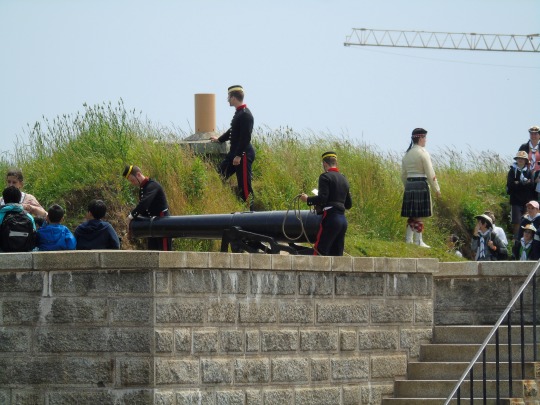



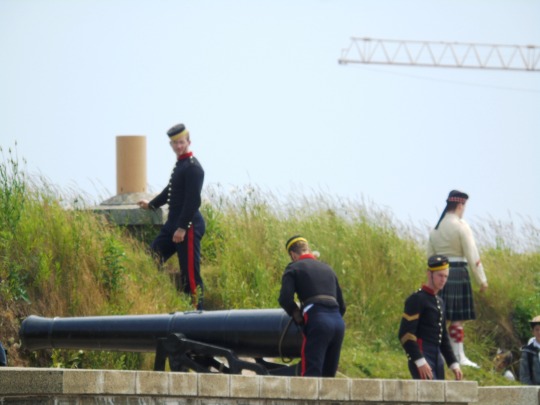
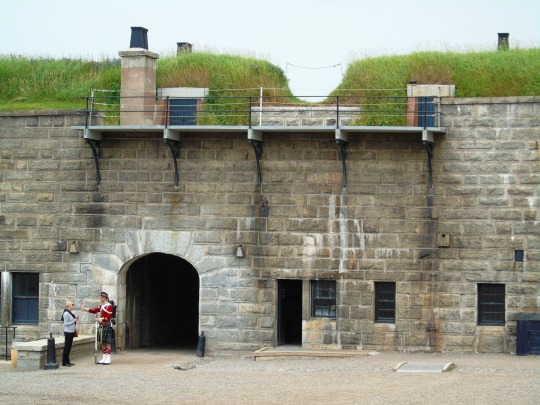

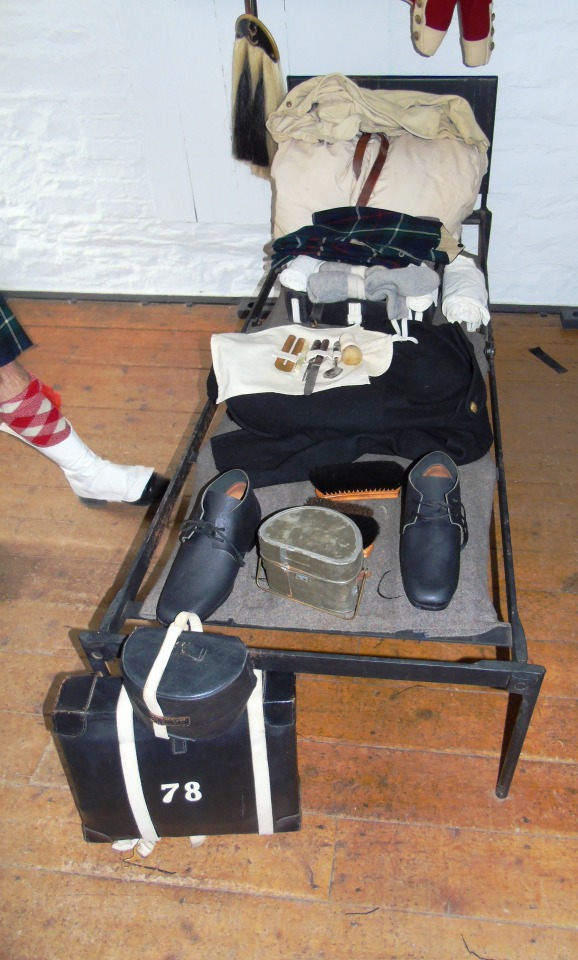



The renowned 78th Highlanders Regiment of Foot were stationed at Halifax for almost three years (1869-1871). The regiment arrived in Halifax on the afternoon of May 14, 1869, aboard the troopship HMS Crocodile.
A total of 765 men disembarked in full dress uniform. The Regiment was divided into two depots and eight service companies, consisting in all of 34 officers, 49 sergeants, 21 drummers, 6 pipers, and 600 rank and file.
#78th Highlanders Regiment of Foot#arrived#Halifax#14 May 1869#history#155th anniversary#Halifax Citadel National Historic Site of Canada#Nova Scotia#summer 2015#original photography#kilt#old uniform#Historical reenactment#landmark#tourist attraction#Fort George#tent#Third Brigade of the Royal Artillery#Barracks#cot#travel#vacation#cityscape#architecture
0 notes
Text
cf & dd timeline
This will not reflect every single aspect of the gilded age (1870s to 1890s) but it will include various points of historical and technological interest in addition to Nell and Steve’s personal histories. As such, spoilers will be included and updated with each chapter; so if you’d rather not deal with that, please avoid this!
Note: Italics denote events of the plot, & updates will occur after chapters are published. This is work in progress so more dates and details will be added as I think of them. Historical dates and information was provided by the National Humanities Center and my own research.
1858 - June: Samuel and Ameila Harrington welcome the birth of their son and heir, Steven.
November: Arthur and Delphine Fairchild welcome the birth of their daughter, Eleanor. (Occurs before the story starts, not depicted.)
1865 - Lincoln Inauguration, Civil War Ends, Lincoln Assassination, Ratification of the 13th Amendment
1866 - the National Labor Union was founded on August 20, First successful transatlantic cable is completed (England to the United States).
1868 - June 25: Congress enacts an 8-hour workday for workers employed by the government, July: Ratification of the 14th Amendment.
1869 - January: Grant Inauguration, Commanche Chief Toch-a-way informs Gen. Philip H. Sheridan that he is a "good Indian," Sheridan reportedly replied: "The only good Indian is a dead Indian."
May: First Transcontinental Railroad completed when Union Pacific and Central Pacific lines met in Utah solidified by a golden railroad spike to link the railroads.
September 24: First “Black Friday” stock market panic due to financier’s attempt to corner the market on gold.
1870 - February: Hiram R. Revels of Mississippi becomes the first African American to serve in the US Senate. Joseph H. Rainey of South Carolina becomes the first Black Representative, J.D. Rockefeller establishes Standard Oil of Ohio.
March: 15th Amendment is Ratified
1871 - P.T. Barnum opens his three-ring circus, hailing it as the "Greatest Show on Earth,"
March: Indian Appropriations Act - Congress declares that Indian tribes will no longer be treated as independent nations with whom the government must conduct negotiations; Native Americans legally become wards of the nation.
October 8: The Great Chicago Fire claims 250 lives and destroys 17,500 buildings.
1872 - Montgomery Ward & Co., the first mail-order business, opens in Chicago.
Nov. 5: Susan B. Anthony and other women's suffrage advocates are arrested for attempting to vote in Rochester, N.Y.
1873 - Grant’s second inauguration, The first electric streetcar begins operation in New York City; Free mail delivery begins in all cities above 20,000 population; Mark Twain and C. D. Warner publish the novel The Gilded Age.
Mar. 3: The Comstock Act prohibits the mailing of obscene literature.
Sept. 18: The Financial Panic of 1873 begins. 5,183 business fail; Congress makes gold the national standard and eliminates all silver currency.
Period of recurring epidemics beginning in 1865 comes to an end. From Boston to New Orleans, epidemics of smallpox, cholera, typhus, typhoid, scarlet fever, and yellow fever had killed thousands.
1875 - Steven begins his studies at Harvard; Nell begins hers at Vassar; Christopher, her older brother begins his final year at Harvard. (Occurs before the story starts, not depicted.)
1876 - Centennial Exposition opens in Philadelphia, celebrating the 100th anniversary of the Declaration of Independence.
Feb. 14: 29-year-old Alexander Graham Bell patents the telephone.
May: The nation celebrates its centennial by opening an International Exhibition in Philadelphia.
Christopher graduates from Harvard and goes on his Grand Tour. (Occurs before the story starts, not depicted.)
June 25: Battle of the Little Big Horn - George A. Custer and 265 officers and enlisted men are killed by Sioux Indians led by Sitting Bull and Crazy Horse at the Little Horn River in Montana.
1877 - Hayes Inauguration, Reconstruction ends with the withdrawal of federal troops in the south, Great Railroad Strike: After West Virginia railroad workers strike to protest wage reductions, sympathy strikes and violence spread across the Midwest. Federal troops break the strikes.
June to Oct.: Nez Percé Indians, led by Chief Joseph, surrender after a 1600-mile trek retreating from U.S. troops through the U.S. northwest. They are sent to a reservation in Indian Territory (Oklahoma).
Thomas Edison patents the phonograph.
Christopher Fairchild weds Marian Hudson. (Occurs before the story starts, not depicted.)
1878 - German engineer Karl Benz produces the first automobile powered by an internal combustion engine; Thomas Edison patents the photograph.
Jan. 10: The Senate defeats a woman's suffrage amendment 34-16.
Steve graduates from Harvard University. (Occurs before the story starts, not depicted.)
1879 - The Carlisle School (Pa.) is opened “Americanize” Indian children.
Feb. 15: Congress grants woman attorneys the right to argue cases before the Supreme Court.
Oct. 21: Edison invents the first practical light bulb.
Steve travels Europe on his Grand Tour; Nell returns to France upon news of her parent’s ill health. (Occurs before the story starts, not depicted.)
1881 - Helen Hunt Jackson's Century of Dishonor recounts the government's unjust treatment of Native Americans.
January: Christopher and Marian Fairchild welcome the birth of their son and heir, August.
May: Steven returns to New York from the Continent; begins working with his father at their various real estate holdings. (Occurs before the story starts, not depicted.)
July 2: President James Garfield is shot by Charles Guiteau, a disgruntled office-seeker. He died on Sept. 19.
July 4: Booker T. Washington opens Tuskegee Institute.
July 19: Sitting Bull and other Sioux Indians return to the United States from Canada.
September: Arthur and Delphine Fairchild pass away after battling tuberculosis; Christopher takes over the family holdings and arranges for his sister to travel back to New York from France; Marian begins paying calls to the Four Hundred and laying the groundwork for Eleanor’s societal debut. (Occurs before the story starts, not depicted but mentioned.)
1882 - Attorney Samuel Dodd devises the trust, under which stockholders turn over control of previously independent companies to a board of trustees; Standard Oil Trust, the first trust, is formed by John D. Rockefeller.
May 6: Congress passes the Chinese Exclusion Act, barring Chinese Chinese immigration for ten years.
December: Eleanor arrives in New York from France entering her half-mourning period and Steven has one-sided meet cute; news the arrival spreads quickly; her debutante ball to be held at the Fairchild manse on 5th Avenue is the talk of the town. (Chapter I. Coup de foudre - story begins here.)
1883 -
January: Mrs. Astor’s annual ball, the most anticipated event of the season, is held; Nell and Steve both receive invitations.
March 26: Mrs. Vanderbilt, feeling snubbed by The Four Hundred, throws her famous masquerade ball, commemorating the completion of her new Fifth Avenue mansion, Petit Château; Nell and Steve are once again invited to the masquerade, but Nell is warned by Marian to keep her distance from Mr. Harrington; each invite has instructions to dress as their assigned characters. (Chapter II. Traîner quelqu'un dans la boue)
3 notes
·
View notes
Photo
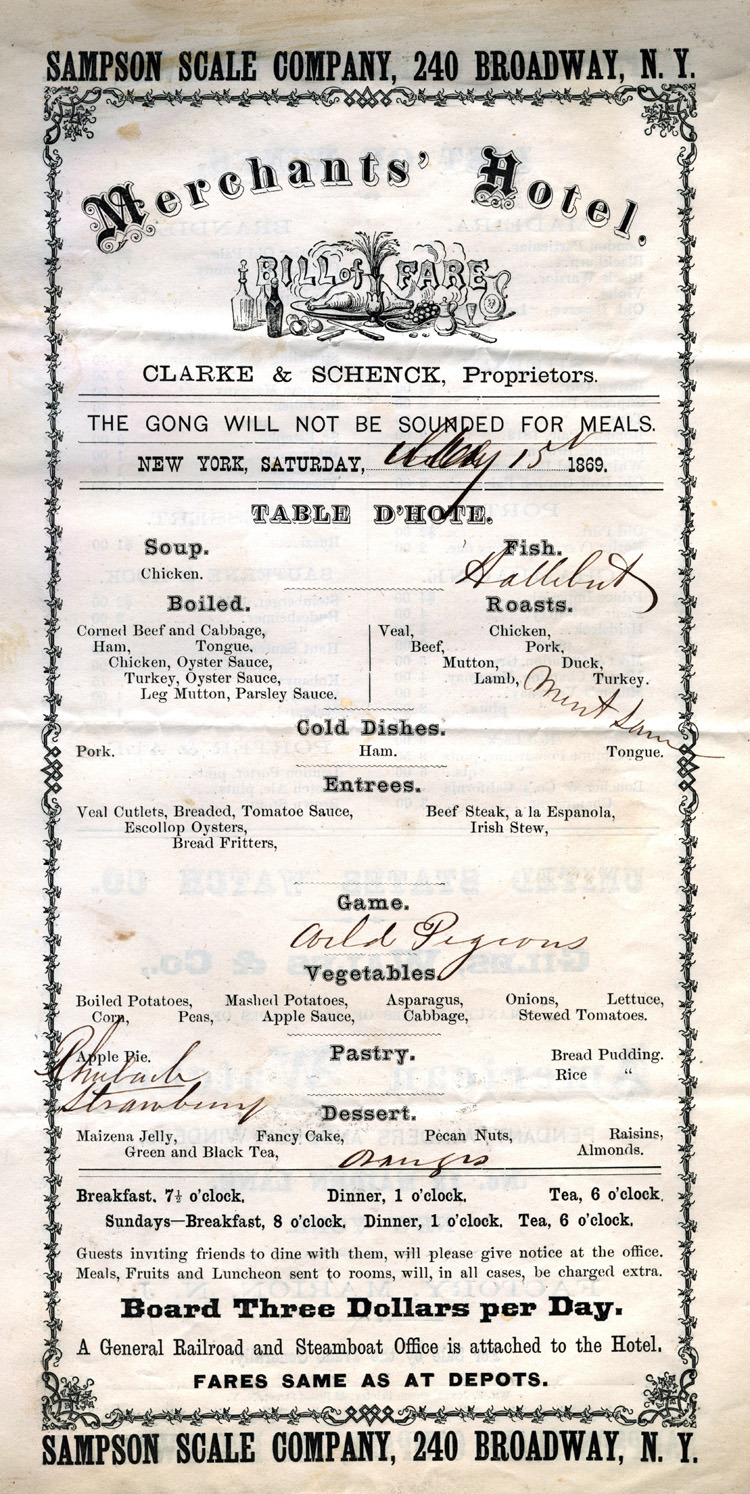
Menu Monday: Henry Cook Thompson, Princeton Class of 1871, pasted this 1869 menu from the Merchants’ Hotel in New York in his scrapbook. We think it was for May 15, but it’s unclear. We are able to make out the other annotations on the menu, however. The fish of the day was halibut, the lamb was served with mint sauce, the game on hand was cold pigeons, there were rhubarb and strawberry pies in addition to apple, and oranges were available for dessert. The rhubarb and strawberries are a stronger suggestion that the month written above is May.
According to the New York Times (April 14, 1878), the Merchants’ Hotel closed permanently in 1878.
Scrapbook Collection (AC026), Box 23
The entire Menu Monday series
18 notes
·
View notes
Text
irl bsd authors
i haven't found a list of irl bsd authors listed from oldest to most recent so i decided to do that. multiple lists for date of birth, death, and publication of the work their ability is based on (if applicable) + fun stuff at the end
birth dates (oldest to most recent)
alexander pushkin - 6 Jun 1799
nathaniel hawthorne - 4 Jul 1804
edgar allan poe - 19 Jan 1809
nikolai gogol - 1 Apr 1809
ivan gonchorav - 18 Jun 1812
herman melville - 1 Aug 1819
fyodor dostoevsky - 11 Nov 1821
jules verne - 8 Feb 1828
saigiku jōno - 24 Sep 1832
louisa may alcott - 29 Nov 1832
yukichi fukuzawa - 10 Jan 1835
mark twain - 30 Nov 1835
ōchi fukuchi - 13 May 1841
paul verlaine - 30 Mar 1844
bram stoker - 8 Nov 1847
tetchō suehiro - 15 Mar 1849
arthur rimbaud - 20 Oct 1854
ryūrō hirotsu - 15 Jul 1861
ōgai mori - 17 Feb 1862
h. g. wells - 21 Sep 1866
natsume sōseki - 9 Feb 1867
kōyō ozaki - 10 Jan 1868
andré gide - 22 Nov 1869
doppo kunikida - 30 Aug 1871
katai tayama - 22 Jan 1872
ichiyō higuchi - 2 May 1872
kyōka izumi - 4 Nov 1873
lucy maud montgomery - 30 Nov 1874
akiko yosano - 7 Dec 1878
santōka taneda - 3 Dec 1882
teruko ōkura - 12 Apr 1886
jun'ichirō tanizaki - 24 Jul 1886
yumeno kyūsaku - 4 Jan 1889
h. p. lovecraft - 20 Aug 1890
agatha christie - 15 Sep 1890
ryūnosuke akutagawa - 1 Mar 1892
ranpo edogawa - 21 Oct 1894
kenji miyazawa - 27 Aug 1896
f. scott fitzgerald - 24 Sep 1896
margaret mitchell - 8 Nov 1900
motojirō kajii - 17 Feb 1901
mushitarō oguri - 14 Mar 1901
john steinbeck - 27 Feb 1902
aya kōda - 1 Sep 1904
ango sakaguchi - 20 Oct 1906
chūya nakahara - 29 Apr 1907
atsushi nakajima - 5 May 1909
osamu dazai - 19 Jun 1909
sakunosuke oda - 26 Oct 1913
michizō tachihara - 30 Jul 1914
tatsuhiko shibusawa - 8 May 1928
(ace) alan bennett - 9 May 1934
yukito ayatsuji - 23 Dec 1960
mizuki tsujimura - 29 Feb 1980
death dates (oldest to most recent)
alexander pushkin - 10 Feb 1837
edgar allan poe - 7 Oct 1849
nikolai gogol - 4 Mar 1852
nathaniel hawthorne - 19 May 1864
fyodor dostoevsky - 9 Feb 1881
louisa may alcott - 6 Mar 1888
ivan goncharov - 27 Sep 1891
herman melville - 28 Sep 1891
arthur rimbaud - 10 Nov 1891
paul verlaine - 8 Jan 1896
tetchō suehiro - 5 Feb 1896
ichiyō higuchi - 23 Nov 1896
yukichi fukuzawa - 3 Feb 1901
saigiku jōno - 24 Jan 1904
jules verne - 24 Mar 1905
kōyō ozaki - 30 Oct 1903
ōchi fukuchi - 4 Jan 1906
doppo kunikida - 23 Jun 1908
mark twain - 21 Apr 1910
bram stoker - 20 Apr 1912
natsume sōseki - 9 Dec 1916
ōgai mori - 8 Jul 1922
ryūrō hirotsu - 25 Oct 1928
ryūnosuke akutagawa - 24 Jul 1927
katai tayama - 13 May 1930
motojirō kajii - 24 Mar 1932
kenji miyazawa - 21 Sep 1933
yumeno kyūsaku - 11 Mar 1936
h. p. lovecraft - 15 Mar 1937
chūya nakahara - 22 Oct 1937
michizō tachihara - 29 Mar 1939
kyōka izumi - 7 Sep 1939
santōka taneda - 11 Oct 1940
f. scott fitzgerald - 21 Dec 1940
lucy maud montgomery - 24 Apr 1942
mushitarō oguri - 10 Feb 1946
h. g. wells - 13 Aug 1946
akiko yosano - 29 May 1942
atsushi nakajima - 4 Dec 1942
sakunosuke oda - 10 Jan 1947
osamu dazai - 13 Jun 1948
margaret mitchell - 16 Aug 1949
andré gide - 19 Feb 1951
ango sakaguchi - 17 Feb 1955
teruko ōkura - 18 Jul 1960
ranpo edogawa - 28 Jul 1965
jun'ichirō tanizaki - 30 Jul 1965
john steinbeck - 20 Dec 1968
agatha christie - 12 Jan 1976
tatsuhiko shibusawa - 5 Aug 1987
aya kōda - 31 Oct 1990
(ace) allan bennett - still alive
yukito ayatsuji - still alive
mizuki tsujimura - still alive
work (oldest to most recent)
alexander pushkin - A Feast in Time of Plague, 1830
edgar allan poe - The Murders in Rue Morgue, 1841
nikolai gogol - The Overcoat, 1842
edgar allan poe - The Black Cat, 19 Aug 1843
nathaniel hawthorne - The Scarlet Letter, 1850
herman melville - Moby-Dick, 1851
louisa may alcott - Little Women, 1858
fyodor dostoevsky - Crime and Punishment, 1866
ivan goncharov - The Precipice, 1869
yukichi fukuzawa - An Encouragement of Learning, 1872-76
jules verne - The Mysterious Island, 1875
mark twain - The Adventures of Tom Sawyer, 1876
mark twain - Adventures of Huckleberry Finn, 1884
tetchō suehiro - Plum Blossoms in the Snow, 1886
arthur rimbaud - Illuminations, 1886
saigiku jōno - Priceless Tears, 1889
ōchi fukuchi - The Mirror Lion, A Spring Diversion, Mar 1893
ryūrō hirotsu - Falling Camellia, 1894
h. g. wells - The Time Machine, 1895
kōyō ozaki - The Golden Demon, 1897
bram stoker - Dracula, 1897 (his ability has not been named, but c’mon, vampires)
akiko yosano - Thou Shall Not Die, 1903
natsume sōseki - I Am a Cat, 1905-06
katai tayama - Futon, 1907
lucy maud montgomery - Anne of Green Gables, 1908
ōgai mori - Vita Sexualis, 1909
andré gide - Strait is the Gate, 1909
kyōka izumi - Demon Pond, 1913
ryūnosuke akutagawa - Rashomon, 1915
motojirō kajii - Lemon, 1924
f. scott fitzgerald - The Great Gatsby, 1925
kenji miyazawa - Be not Defeated by the Rain, 3 Nov 1931
santōka taneda - Self-Derision, 8 Jan 1932
mushitarō oguri - Perfect Crime, 1933
chūya nakahara - This Tainted Sorrow, 1934
yumeno kyūsaku - Dogra Magra, 1935
margaret mitchell - Gone With the Wind, 1936
john steinbeck - The Grapes of Wrath, 1939
agatha christie - And Then There Were None, 6 Nov 1939
atsushi nakajima - The Moon Over the Mountain, Feb 1942
jun'ichirō tanizaki - The Makioka Sisters, 1943-48
ango sakaguchi - Discourse on Decadence, 1946
teruko ōkura - Gasp of the Soul, 1947
osamu dazai - No Longer Human, 1948
(ace) alan bennett - The Madness of King George III, 1995
yukito ayatsuji - Another, 2005
mizuki tsujimura - Yesterday’s Shadow Tag, 2015
can’t find dates:
michizō tachihara - Midwinter Memento
sakunosuke oda - Flawless
n/a: doppo kunikida, ranpo edogawa, ichiyō higuchi, h. p. lovecraft “Great Old Ones” (fictional ancient dieties eg. cthulhu), aya koda, paul verlaine, tatsuhiko shibusawa “Draconia” (umbrella term for shibusawa’s works/style)
bonus:
elise - The Dancing Girl (1890) by ōgai mori
shōsaku katsura - An Uncommon Common Man by doppo kunikida
Nobuko Sasaki (20 Jul 1878 - 22 Sep 1949) - doppo kunikida’s first wife
gin akutagawa - O-gin (1922) by ryūnosuke akutagawa
naomi tanizaki + kirako haruno - Naomi (1925) by jun'ichirō tanizaki
t. j. eckelburg + tom buchanan - The Great Gatsby (1925) by f. scott fitzgerald
the black lizard - Back Lizard (1895) by ryūrō hirotsu (+ The Black Lizard (1934) by ranpo edogawa)
some fun facts:
the oldest: aya koda 86, andré gide 81, h. g. wells 79, jun'ichirō tanizaki 79, ivan goncharov 79 (alan bennett is 89 but still alive)
the youngest: ichiyō higuchi 24, michizō tachihara 24, chūya nakahara 30
yukito ayatsuji’s Another is also an anime, released in 2012
both edgar allan poe and mark twain’s ability consist of two of the author’s work
14 notes
·
View notes
Text
The Hijikata family in the Ishida village census
I continue to read the book The demon lieutenant of Shinsengumi. This is in fact a collection of articles by different authors, each with their own way of retelling some moments from Hijikata's life. And one of the authors - my favorite Kikuchi Akira - really dug up something new!
Kikuchi Akira is a Bakumatsu researcher who is always getting into the thick of things: comparing the Okita's kaimyo (posthumous Buddhist name) and the kaimyo of his supposed girlfriend, or parsing Hijikata's letters. And now he has found the census books of Ishida village from 1817 to 1869, which refute the official opinion that Toshizo was fired from one job at 11 and another at 17. According to the new records, he was listed "in the people section" at a completely different age and for quite a long time! In addition, these records reveal some peculiarities of the Japanese population of the century before the last century.
These are the family registration books:

There are 20 volumes of them, and they were kept until recently by a certain Hijikata Satoshi, who only deigned to share them with the public about five years ago (how many more of these things are still stashed away in private archives!).
So, in Japan, throughout the Edo period, monks conducted a census of the population. They sent the data to the shogunate and kept a copy for themselves. The original purpose of this census was to prevent the spread of Christianity, so special books listed all members of each family, along with their servants, their ages, and their religion.
It is difficult to say how often this information was collected, because in Ishida village the census was conducted either once every five years, or every year. But it was always in March.
Hijikata Toshizo was born in May 1835, and the first record of him in the registration book did not appear until March 1840:
parishioner of the Kongoji Shrine of Takahata Village - Toshizo, age 6 [4.5 years old according to our age system]
His name was then written as 歳蔵 throughout the census.
The author provides only one entry entirely about the Hijikata family, in 1848. This is roughly what it looked like:
Income 20 koku, 1 to 1 sho 4 go 7 yu
一 Shingon Sect, Takahata Village, Kongoji Temple
Parishioner - Hayato, 28 years old
Parishioner of the same temple - Wife Naka, 23 years old.
Parishioner of the same temple - Elder brother Tamejiro, 33 years old.
Parishioner of the same temple - Daughter Nui, 7 years old.
Parishioner of the same temple - Son Sakusuke, 4 years old.
Parishioner of the same temple - Servant Hachigoro, 19 years old
一 Zen sect, Yaho village, Nanyoji temple
Parishioner - Maid Hatsu, 21 years old
一 Shingon sect, Shitada village, Anyoji temple
Parishioner - Maid Fude, 12 years old
A total of 8 people, of which 4 are male, 4 are female.
Two more males are in service in other houses:
一 Shingon sect, Takahata village, Kongoji temple
Parishioner - Younger brother Daisaku, 20 years old
Parishioner of the same temple - Younger brother Toshizo, 14 years old
By our age system, everyone here is a year younger. Daisaku was probably about to be adopted by the Kasuya doctor family at that time. As for where Toshi was, it's unknown. Though maybe at his sister's...
The official biography says that in 1845 he was employed in the fabric store Matsuzakaya in Ueno, where the owner was a certain Ito. There Toshi quarreled with the clerk and fled home. And this article even says where this information comes from: it turns out that in 1935, the grandson of Sato Hikogoro and Hijikata Nobu talked about it on the radio.
This same Matsuzakaya still exists today. Here's its website. It's even in English.
The census book for 1845 also exists, but in it, the page about the Hijikata family was "deliberately defaced by someone," as Kikuchi Akira writes. But it's easy to reconstruct the rest from the surviving pieces:
一 Zen sect, Yaho village, Nanyoji temple
Parishioner - Servant Tsunakichi (or Tsunayoshi), 21 years old
一 Shingon Sect, Ochikawa Village, Shinshoji Temple
Parishioner - Maid Kuni, 17 years old
A total of 8 people, of which 5 are male, 3 are female.
Another 1 female is in the service of another house:
一 Shingon Sect, Takahata Village, Kongoji Temple
Parishioner - Younger sister Ran, 15 years old
Ran was Nobu's childhood name. In theory, she married Sato Hikogoro a year ago, and should have been listed in his household by now. But since she's recorded still in it, Kikuchi-san explains, that means her marriage was nominal at first. It was called asiirekon (足入れ婚 ), when one sort of got married, but the wife continued to live in her parent's house. Or maybe "in the service" meant she was living with Sato anyway.
On the defaced page there should be four more "males" and two females: Hayato, Tamejiro, Daisaku, Toshizo; wife Naka, daughter Nui. Sakusuke was born in 1845, the same year (i.e. not yet born in March), and there is no one "in the service" besides Ran.
So Kikuchi-san, based on the study of some other "private documents", concluded that Hijikata worked for this very Ito from about 12-13 and up to 16 years old (according to our age system), and the story of "quarrel with the clerk" and "dismissal because of a girl" took place at the same location.
But in Hijikata's family another version was passed down from generation to generation: that Toshizo first worked in Ueno, and then in Tenmacho, also in a fabric store, and that's where the story with the girl happened. Hijikata has a haiku about Tenmacho, so he was definitely there :) It's just unknown exactly when.
That Toshizo returned home at the age of 16 (in 1851) is a confirmed fact. This is written about in Kojima Shikanosuke's book "両雄士伝" - "The Lives of Two Great Warriors" written in 1873. About Kondo and Hijikata, yep. The very fact that this book exists is a big surprise to me - it's strange that no mention of it has ever been found anywhere! You can understand why though: it's written in kanbun, a hellish mixture of Chinese and Japanese. So, this book says that Toshizo returned to his hometown at the age of 17 (i.e. 16) and began practicing martial arts, in which he soon became very successful.
Anyway, he started selling Ishida Sanyaku and going to different dojos.
However, the monastic registration books for 1854 and 1856 still show "two more males are in the service of other houses". It was not until 1858 that the record that Toshi was finally home appeared for the first time.
Income 39 koku, 7 to 8 go
一 Shingon Sect, Takahata Village, Kongoji Temple
Parishioner - Hayato, 38 years old.
… wife Naka, 33
…older brother Tamejiro, 43 years old.
…younger brother Toshizo, 24.
(then there are 6 children, 1 servant and 1 maid)
Total 12 people, 9 male, 3 female.
On March 9, 1859, Hijikata was officially enrolled as a student at the Kondo dojo. There is an entry about it in the "Registration book of the Tennen Rishin-ryu" (天然理心流神文帳 ), and then in the diaries of relatives, friends and neighbors there are many entries such as "Toshizo came with Okita Soji, both stayed at our place for the night" (Hashimoto's diary, 09-03-1860), or "Toshizo and Kondo Isami went to Itsukaichi" (Sato's diary, 09-05-1860).
In August 1860, another official registration book was published called "Bujutsu eimei roku" (武術英名録 ) - something like "Names of Glorious Swordsmen". It included the names of 600 swordsmen from all over the Kanto region, including Hijikata. Only those who had a rank no lower than mokuroku were enrolled there, and Hijikata would not have been able to get mokuroku in such a short time if he had not studied the sword before, writes Kikuchi Akira. So he did study, but where - that's the question. That is, what kind of "service" he was in from 1853-4 to 1857-8 is unknown. Maybe he just lived at Sato's house and walked around, selling medicine, but Sato has no mention of it. So this is "another mystery" for Japanese historians.
14 notes
·
View notes